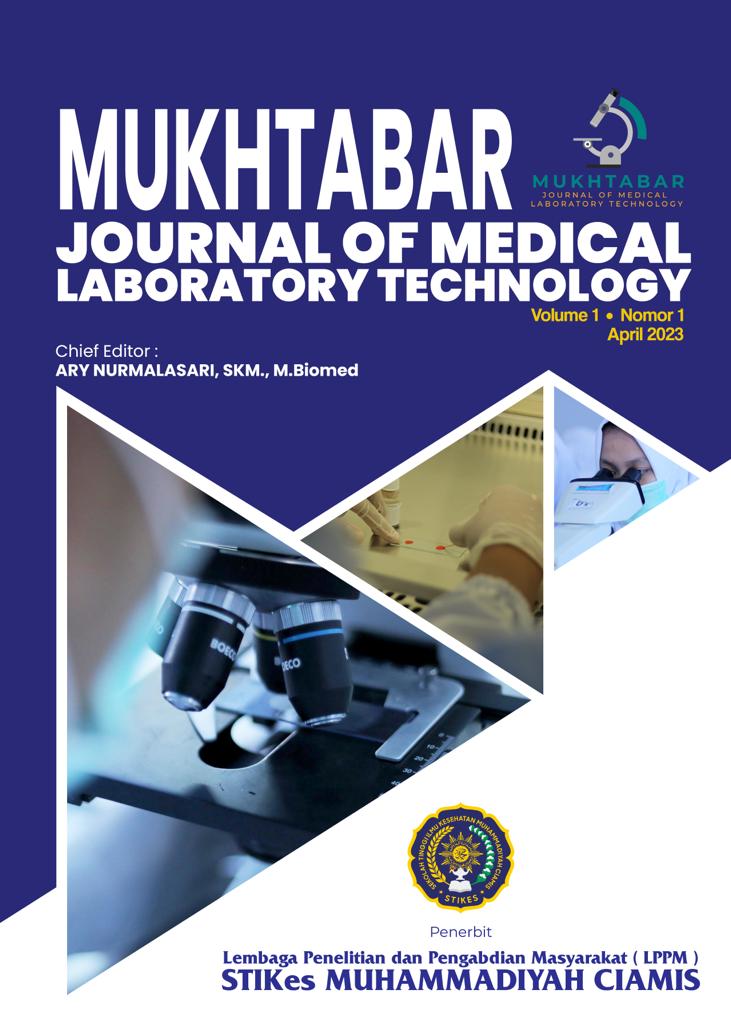Erythrocyte Index and Mentzer Index in Fathers of Thalassemia Patients
DOI:
https://doi.org/10.52221/mjmlt.v1i1.219Keywords:
Thalassemia, Erythrocyte Index, Mentzer IndexAbstract
Background & Objective Thalassemia is a blood disorder caused by genetic factors that cause the globin chain in hemoglobin to not function normally. It is the most common hereditary disease in the world and in Ciamis Regency in 2021 there were 191 patients. Thalassemia prevention is carried out by screening to identify thalassemia carriers. Hematological examination in the form of erythrocyte index (MCV, MCH, MCHC) and mentzer index has been known to determine thalassemia screening. The purpose of this study was to determine the description of erythrocyte index and mentzer index in thalassemia patient's father.
Method The method used in this study is descriptive method. The population in this study were members of POPTI (Parents Association of Thalassemia Patients) Ciamis Regency. The sample in this study were 30 samples.
Result Based on the results of the study obtained the results of erythrocyte index (MCV, MCH) low (MCHC) normal and Mentzer index obtained the results of 20 samples (66%) suspected as thalassemia carrier, 5 samples (17%) suspected iron deficiency anemia and according to the reference value there were 5 samples (17%).
Conclusion The results of a study conducted on 30 fathers of thalassemia patients showed that 83% of fathers of thalassemia patients had MCV and MCH values below the normal threshold and 73% had normal MCHC values. Furthermore, from the results of the Mentzer index examination, it is known that 66% of the fathers of thalassemia patients are suspected of having minor thalassemia, 17% are suspected of having iron deficiency anemia disorders and 17% have a normal Mentzer index.
References
Barbara Jane Bain. (2014). Hematologi: a core curriculum (A. sekartiwi Anggraini Iriani, Y.Joko suyono, Ferdy sandra (ed.); Edisi 1). Buku Kedokteran EGC.
Maharani, E. A., & Astuti, D. (2014). Penghitungan Indeks Formula Eritrosit Pada Uji Saring Thalasemia Minor. Jurnal Ilmu Dan Teknologi Kesehatan, 2(1), 53–59. http://ejurnal.poltekkesjakarta3.ac.id/index.php/jitek/article/download/124/92
Regar, J. (2013). Aspek Genetik Talasemia. Jurnal Biomedik (Jbm), 1(3). https://doi.org/10.35790/jbm.1.3.2009.829
Rujito, L. (2020). Buku Referensi Talasemia: Genetik Dasar dan Penanganan Terkini (Issue January). https://doi.org/10.31227/osf.io/y8ez4
Santoso, A. (2010). Studi Deskriptif Effect Size Penelitian-Penelitian Di Fakultas Psikologi Universitas Sanata Dharma. Jurnal Penelitian, 14(1), 1–17. https://doi.org/0022-3913
Suhartati, R. (2015). Gambaran Indeks Eritrosit Pada Pasien Tuberkulosis Paru. Jurnal Kesehatan Bakti Tunas Husada: Jurnal Ilmu-Ilmu Keperawatan, https://doi.org/10.36465/jkbth.v14i1.108
Syobri, M., Mustofa, F. L., & Triswanti, N. (2020). Hubungan Kepatuhan Konsumsi Kelasi Besi Terhadap Pertumbuhan Anak Dengan Thalassemia. Jurnal Ilmiah Kesehatan Sandi Husada, 11(1), 387–391. https://doi.org/10.35816/jiskh.v11i1.300
Downloads
Published
How to Cite
Issue
Section
License
Copyright (c) 2023 Rhama Adiguna, Doni Setiawan, Undang Ruhimat, Rahayu Nirmatul Mutmainah

This work is licensed under a Creative Commons Attribution 4.0 International License.









